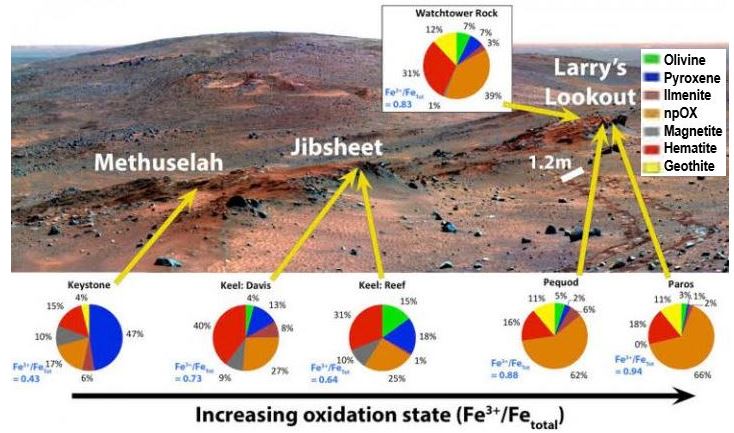Mars has acid fog that scientists believe may have eaten at rocks in a 100-acre area on Husband hill in the Columbia Hills of Gusev Crater. Planetary scientist, Shoshanna Cole, Assistant Professor at the Department of Physics and Astronomy, Ithaca College, said the fog is caused by volcanic eruptions.
Prof. Cole used a variety of data collected by several instruments on the 2003 Mars Exploration Rover Spirit to glean information from exposures of the ancient bedrock.
She presented her work on November 2nd at the annual meeting of the Geological Society of America in Baltimore, Maryland (citation below).
 A false-color mosaic of Cumberland Ridge, with superimposed pie charts representing iron-bearing mineralogy. A lay person can see the stuff represented by the pie charts varies enormously across this scene. (Image: eurekalert.org. Credit: S. Cole, PhD thesis.)
A false-color mosaic of Cumberland Ridge, with superimposed pie charts representing iron-bearing mineralogy. A lay person can see the stuff represented by the pie charts varies enormously across this scene. (Image: eurekalert.org. Credit: S. Cole, PhD thesis.)
Prof. Cole explained that the work concentrated on the ‘Watchtower Class’ outcrops on Cumberland ridge and the Husband Hill summit.
Rocks provide billions of years of Martian history data
Prof. Cole said:
“The special thing about Watchtower Class is that it’s very widespread and we see it in different locations. As far as we can tell, it’s part of the ground there.”
The rocks record environments that existed on the Red Planet billions of years ago.
After combining data from previous studies of the Martian area, Prof. Cole noticed some intriguing patterns emerge.
Spirit gathered data on Watchtower Class rocks at a dozen locations spanning approximately 200 meters along Cumberland Ridge and the Husband Hill summit.
Spirit’s Alpha Proton X-ray Spectrometer (APXS) determined that the chemical composition of these rocks was the same, but not as far as the other instruments were concerned.
Across Cumberland Ridge – which is about one-third the size of a football field – Mössbauer Spectrometer revealed a surprisingly wide range in the proportion of oxidized iron to total iron, as if something had reacted with the rocks’ iron to different degrees.
Widely different oxidation states
Across a span of just 30 meters, the oxidation state ranged from 0.43 to 0.94. Meanwhile, data from both the Miniature Thermal Emission Spectrometer (Mini-TES) and the Mössbauer Spectrometer showed that the rocks’ minerals lost their structure, becoming less crystalline and more amorphous (without a clearly defined shape or form).
These trends matched the size of the agglomerations (small bumps) seen in Pancam and Microscopic Imager pictures of the rocks.
Prof. Cole said:
“So we can see the agglomerations progress in size from west to east and the iron changes in the same way. It was super cool.”
Rocks started the same, then diverged
However, the fact that these rocks were otherwise the same in composition suggests that they were originally identical. “That makes us think that they were made of the same stuff when they started out. Then something happened to make them different from each other,” Prof. Cole explained.
Prof. Cole hypothesized that the rocks had been exposed to acidic water vapor (acid fog) from volcanic eruptions, similar to the ‘vog’ (volcanic smog) that posed health hazards from the eruptions of Kilauea in Hawaii.
When the ‘vog’ in Mars landed on the rocks’ surface, it dissolved some minerals, forming a gel. Then the water evaporated, leaving a cementing agent behind that resulted in the agglomerations.
Prof. Cole said:
“So nothing is being added or taken away, but it was changed. This would have happened in tiny amounts over a very long time. There’s even one place where you see the cementing agent healing a fracture. It’s pretty awesome. I was pretty happy when I found that one.”
More support for this idea comes from a 2004 study in which researchers carried out laboratory experiments exposing pretend Martian basalt rocks to sulfuric acid and hydrochloric acids.
The results suggest that as these rocks are exposed to acids, their crystalline structure is lost – just like what Prof. Cole sees in varying degrees across the Watchtower Class.
Rocks exposed to more Sun and wind less altered
Why there is a trend in the iron and the varying degrees to which the rocks were changed is due to microclimates, as occurs in different areas of our home gardens on Earth.
How long the gel was present on the rocks depended on how much wind and sunshine they were exposed to. The more altered rocks, which have larger bumps, are on very steep slopes that face away from the Sun, i.e. they are in shadier areas. The rocks on the sunnier and gentler slops are the least altered.
Prof. Cole said:
“Spirit’s the rover who always had to try harder. She was sent to Gusev Crater to look for lake deposits, but landed in lava field. She had to make a long trek to the Columbia Hills to find evidence of ancient watery environments. There’s still tons of data to analyze there, and that’s really nifty.”
Citation: “IN-SITU EVIDENCE FOR ALTERATION BY ACID FOG ON HUSBAND HILL, GUSEV CRATER, MARS,” COLE, Shoshanna B. 2015 GSA Annual Meeting in Baltimore, Maryland, USA (1-4 November 2015). Paper No. 94-10.
